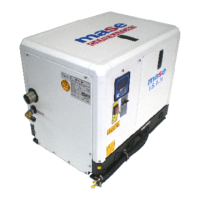IS 6.1
- 30
GB
GB
MAX MIN
1
1
2
3
4 USING THE GENERATOR
4.1 PRELIMINARY CHECKS
Before beginning with any starting procedures, it is
extremely important to “familiarise” yourself with the
generator and its controls.
Furthermore, visually inspect the generator and the
installation.
Any source of real or potential risk must be eliminated
before proceeding.
- Identify the position of the emergency stop buttons,
switches andother emergency systems onthe generator.
- Learn the specific emergency procedures pertaining
to the installation in question.
- Check the oil level by means of the dipstick (ref. 1).
See table for recommended oils (chap.6.4)
- Check that all the anchoring points of the generator
are properly tightened.
- Check that all the electrical utilities are off to prevent
starting the generator on load.
- Check that the water and fuel pipes are properly
connected
- Check that all the electrical connections have been
properly made and that no connections are in a bad
state.
- Check that the seawater cock is open (ref. 2)
- If a checkvalve has been fittedon the seawater intake
(as recommendedin the installation manual), check that
the section of the water circuit leading from the pump to
the valve has been manually primed (ref.3).
4.2 FUELLING
The fuelling operations must be carried out extremely
carefully and the tank must not be filled over the
maximum level.
- Fuel is a toxic and flammable liquid, and must
thereforebe kept in hermetically sealed containers
and stored in inaccessible places.
- Fuelling must always be carried out withthe engine
off and the selector in the OFF position.
- Do notsmoke and do not use naked flames during
fuelling.
- Fuel in well-ventilated places.
-Avoidcontact offuel withthe skinand donot inhale
the fumes.
OPEN

